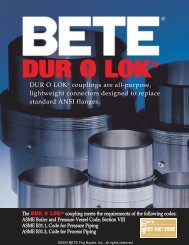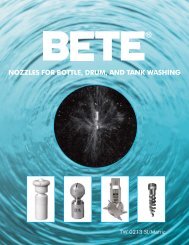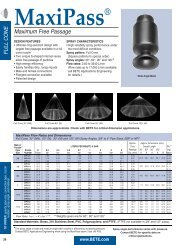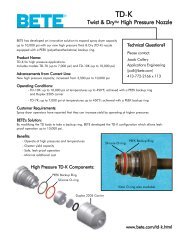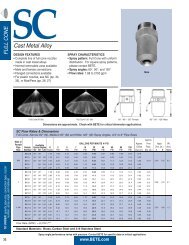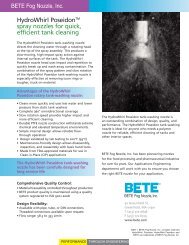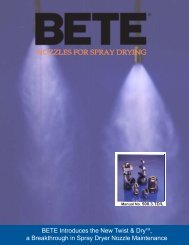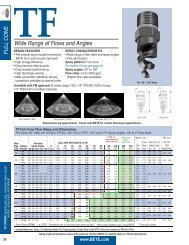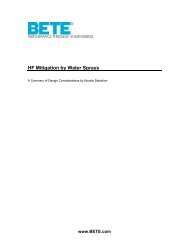Spray Gas Quench Design Considerations - BETE Fog Nozzle, Inc.
Spray Gas Quench Design Considerations - BETE Fog Nozzle, Inc.
Spray Gas Quench Design Considerations - BETE Fog Nozzle, Inc.
- No tags were found...
You also want an ePaper? Increase the reach of your titles
YUMPU automatically turns print PDFs into web optimized ePapers that Google loves.
Maintenance <strong>Considerations</strong>Maximum reliability can often beenhanced with simple system configurationsuch as strainers to prevent smallamounts of solids from plugging nozzles,as mentioned above. If nozzles are subjectto high temperature environments anddo not continually have a flow of liquidor atomizing gas, the nozzle will overheatand material failure can result. The risk ofan unplanned shutdown is reduced withscheduled maintenance to manage wearor erosion of nozzles and to inspect forpartial clogging and overheating nozzles.We recommend visual inspection and thedevelopment of a routine replacementplan. Some systems require nozzlechange-out every 1 to 2 years to fullymaintain the process performance. Forclean liquid service an annual inspectionis a starting point for a PM (PreventativeMaintenance) program.Examples of <strong>Spray</strong> <strong>Quench</strong> ApplicationsThe examples below provide aperspective on the range of designsand considerations involved insystem design.Pressurized <strong>Gas</strong> <strong>Quench</strong>A large-scale reactor gas dry wall quenchsystem was used by a customer to cool apressurized gas stream (~100 psi) from1000° C to 250°C to protect downstreamequipment. Because this system wasrefractory lined, a dry-wall design wasessential to prevent excessive thermalstresses on the refractory. A high degreeof turndown (8:1) was necessary tomanage conditions from startup to fullrate operation. The system geometry,shown in Figure 11, had a short distancebetween the liquid injection point and theend of the refractory lining. The customerinitially used a nozzle (not from <strong>BETE</strong>)that cooled only to 500° C. The nozzleused was a spring-loaded pintle typedesigned as a steam-desuperheatingnozzle, which resulted in a large dropsize at a higher flow. <strong>BETE</strong> ApplicationsEngineering analysis showed theexcessive drop size produced by thisnozzle and the system configuration werethe root causes of inadequate cooling.The spray impinged on the refractory walland liquid flowed at the bottom of thepiping. The surface area of the liquidstream flowing co-currently with the gaslimited the ineffective heat transfer.The system designed in collaboration<strong>BETE</strong> Applications Engineering was agroup of 19 <strong>BETE</strong> TF 8 FC nozzlesarranged as shown Figure 11B. Thesewere sized to operate at a pressure dropof 200 psi to achieve the desired dropsize and spray penetration into the highvelocity gas steam. The system requiredthe addition of a high-pressure centrifugalpump to deliver quench water to the spraynozzles. Three lateral headers were usedto manage the turndown. At low rate onlyone header would be in operation and agas purge would cool the other headers.Full rate operation would have all threeheaders in operation.The resulting quench system design onlyrequired fine-tuning of the transitionpoints between the operation of one, two,and three headers. High reliability wasachieved with careful consideration of allthe operating modes and proper materialselection even though the spray lanceswere in a harsh high temperatureenvironment.<strong>Quench</strong>LiquidCooled gasoutletHot gas inletFigure 11A. Cross section oforiginal system showing nozzlecentrally mounted in the 1 meterID system.Header 1Header 2Header 3Figure 11B. End view of headersystem and nozzles.8PERFORMANCE THROUGH ENGINEERING



